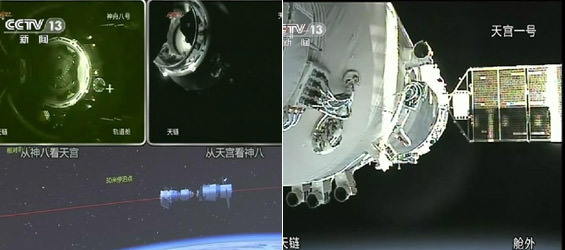What more can we say? The view from the International Space Station is incredible, and this latest time-lapse sequence of photographs was put together by Michael König. These views are taken with a special low-light 4K-camera now on the Space Station, and covers August to October, 2011. The crews of expedition 28 & 29 were behind the camera, while König refurbished, smoothed, retimed, denoised, deflickered, and cut, etc. You can see all the images taken with this new camera at the Image Science & Analysis Laboratory website, The Gateway to Astronaut Photography of Earth
Soyuz Poised for High Stakes November 13 Blastoff – Space Stations Fate Hinges on Success
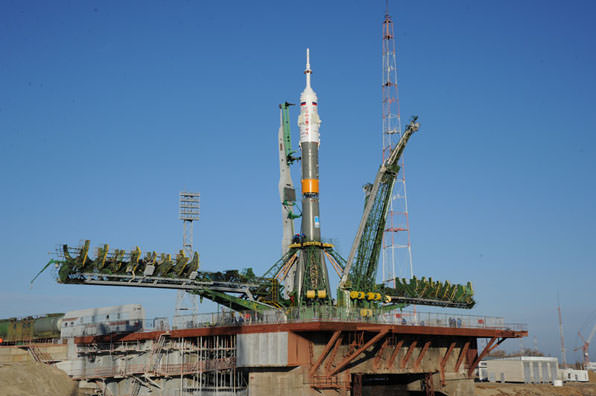
[/caption]
The stakes could not be higher for the Russian Soyuz rocket now poised at the launch pad at Baikonur in Kazakhstan and which will loft the next trio of space flyers to the International Space Station on Sunday, Nov. 13. This is the first flight of a manned Soyuz rocket since the Space Shuttle was retired in July and the subsequent failure of an unmanned Soyuz booster in August of this year.
The booster was rolled out to the pad on Friday (Nov. 11) and the very fate of the Space Station and the partners $100 Billion investment hinges on a successful blastoff of the venerable Soyuz – which dates back to cosmonaut Yuri Gagarin and the inauguration of human spaceflight 50 years ago. This launch must succeed in order to keep a human presence aboard the ISS and comes in the wake of an upper stage failure days ago that left Russia’s ambitious Phobos-Grunt Mars mission stranded in Earth orbit and potentially doomed. See the Soyuz rollout video and pictures below
The Soyuz rocket and spacecraft were rolled out on a rail car at Baikonur
Video Caption – Rollout of Soyuz TMA-22 spacecraft and booster to Baikonur launch pad in Kazahkstan.
Following the August 24 launch failure and crash of a Soyuz rocket carrying the Progress 44 cargo resupply vehicle to the ISS, Russia’s manned space program was grounded because the third stage of the Soyuz rocket which malfunctioned is virtually identical for both the manned and unmanned versions.
Since NASA was forced to shut down the Space Shuttle program, the Russian Soyuz rocket and capsule are the sole method of transport to the ISS. Thus, American astronauts have no choice but to hitch a ride with the Russians.
No American replacement spacecraft will be ready for humans until 2014 at the very earliest. And significant NASA budget cuts are likely to delay the introduction of the proposed “space taxis” by several more years.
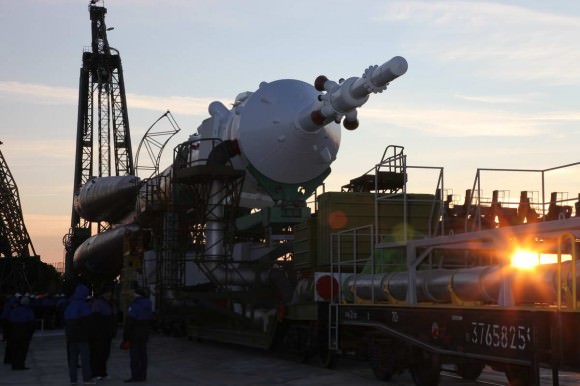
Liftoff off the three man crew aboard the Soyuz-TMA 22 capsule from the Baikonur Cosmodrome in Kazakhstan is slated for 11:14 p.m. EST Sunday Nov. 13 (11:14 a.m. Baikonur time Monday, Nov. 14) aboard the Soyuz TMA-22 spacecraft.
Originally, the launch of the Soyuz TMA-22 crew had been scheduled for September 22 but was immediately put on indefinite hold following the August 24 crash.
Russia promptly announced the formation of a special state commission to investigate the failure, which rapidly traced the malfunction to a clogged fuel line and instituted fixes and stricter quality control measures.
Fortunately, the program got back on track 10 days ago when the Soyuz rocket for the unmanned Progress 45 cargo ship successfully blasted off from the Baikonur Cosmodrome on Oct. 30, 2011 and docked two days later at the ISS.
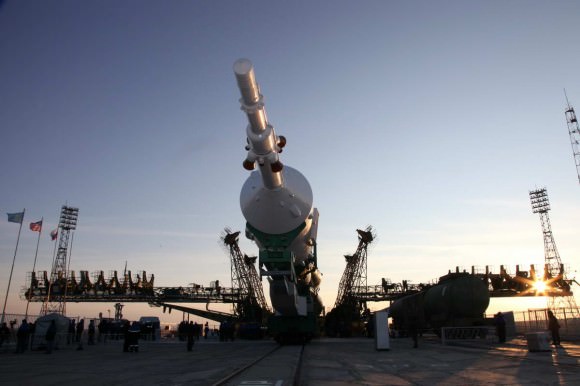
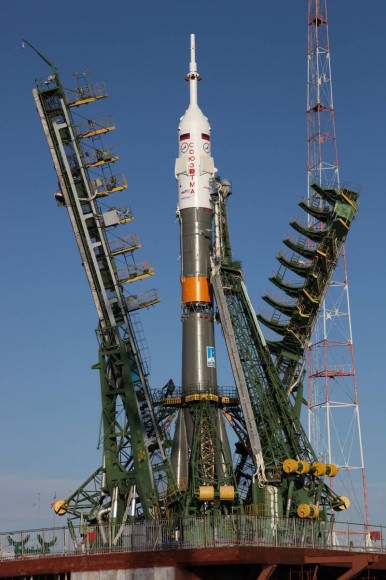
The international trio of new ISS residents consists of Expedition 29 Flight Engineer Dan Burbank from NASA and Anton Shkaplerov and Anatoly Ivanishin from Russia.
After a 2 day chase, they are due to link up with the ISS when their spacecraft docks to the Poisk mini-research module at 12:33 a.m. Wednesday.
When Burbank, Shkaplerov and Anatoly Ivanishin dock they will join the other trio of Expedition 29 crewmembers already aboard the ISS; Expedition 29 crewmates Commander Mike Fossum (NASA) and Flight Engineers Satoshi Furukawa (Japan) and Sergei Volkov (Russia) – and temporarily restore the ISS to a full complement of 6 crewmembers.
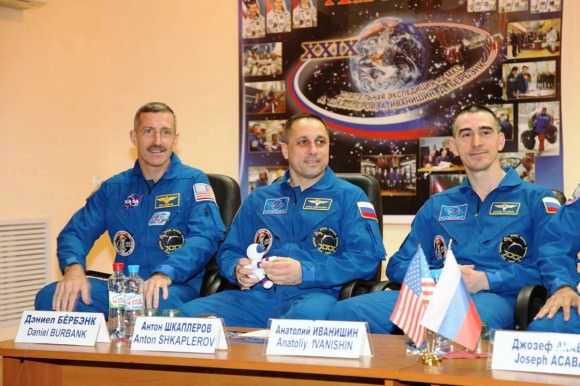
But the full ISS staffing will be short-lived, because Fossum, Furukawa and Volkov will hand over all ISS duties to the new crew and undock their Soyuz TMA-02M capsule from the Rassvet research module on Nov. 21 and depart for Earth reentry and landing in Kazakhstan hours later.
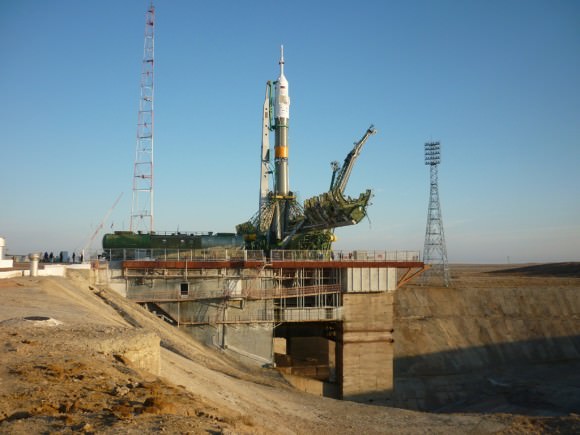
The new crew of three must reach the ISS before the current trio departs or the ISS would be left unmanned for the first time in over 11 years.
Read Ken’s continuing features about Russian Space Programs including Soyuz, Progress, Phobos-Grunt and Soyuz in South America starting here:
Success ! Launch Video of Crucial Russian Rocket to ISS puts Human Flights back on Track
Russians Race against Time to Save Ambitious Phobos-Grunt Mars Probe from Earthly Demise
Russia’s Bold Sample Return Mission to Mars and Phobos Blasts Off
Video Duet – Soyuz Debut Blast off from the Amazon Jungle and Rockin’ Russian Rollout !
Historic 1st Launch of Legendary Soyuz from South America
Russian Soyuz Poised for 1st Blastoff from Europe’s New South American Spaceport
Orion Spacecraft to Launch in 2014

[/caption]
CAPE CANAVERAL, Fla – NASA has announced its intention to launch an unmanned flight of the Orion Spacecraft atop a United Launch Alliance (ULA) Delta IV Heavy launch vehicle – by 2014. This flight test will be added to the contract that the space agency has with aerospace firm Lockheed Martin. The Orion Multi-Purpose Crew Vehicle or Orion MPCV as it is more commonly known – will test out systems that will be employed on the Space Launch System (SLS). If successful, this will allow astronauts to travel beyond low-Earth-orbit (LEO) for the first time in over four decades.
“This flight test will provide invaluable data to support the deep space exploration missions this nation is embarking upon,” said NASA Associate Administrator for Communications David Weaver.
The flight has been dubbed Exploration Flight Test or EFT-1 and will be comprised of two high-apogee orbits that will conclude with a high-energy reentry into the Earth’s atmosphere. Like the Mercury, Gemini and Apollo capsules before it, the Orion MPCV will conduct a water landing.
The test mission will lift off from Cape Canaveral Air Force Station located in Florida. It is designed to provide the space agency with vital flight data regarding how the vehicle handles re-entry and other performance issues.
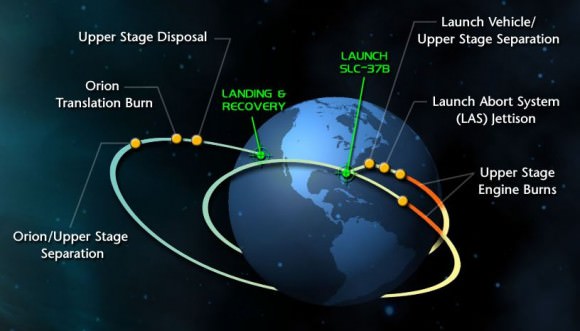
“The entry part of the test will produce data needed to develop a spacecraft capable of surviving speeds greater than 20,000 mph and safely return astronauts from beyond Earth orbit,” said Associate Administrator for Human Exploration and Operations William
Gerstenmaier. “This test is very important to the detailed design process in terms of the data we expect to receive.”
Presumably the use of a Delta IV Heavy would allow NASA to accelerate its human exploration objectives at an accelerated rate. Since the flight will be unmanned, there is no need to man-rate the launch vehicle and given the current economic issues facing the United States, the use of so-called “legacy” hardware could ensure that costs are kept down.
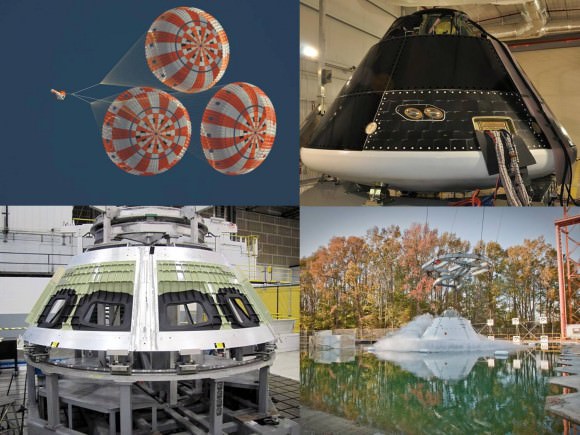
NASA has also stated its intention to release competitive solicitations for design proposals for new, advanced liquid or solid boosters to be used on the SLS. Another contract that will be opened for competition will be for payload adaptors for both crewed as well as cargo missions.
The Orion spacecraft was originally part of the Constellation Program. Its design has since been modified – but its mission to one day fly astronauts to the Moon, Mars and beyond – remains. The EFT-1 test flight will allow technicians and NASA officials to better determine what further changes need to be made to best aid the completion of NASA’s exploration goals.
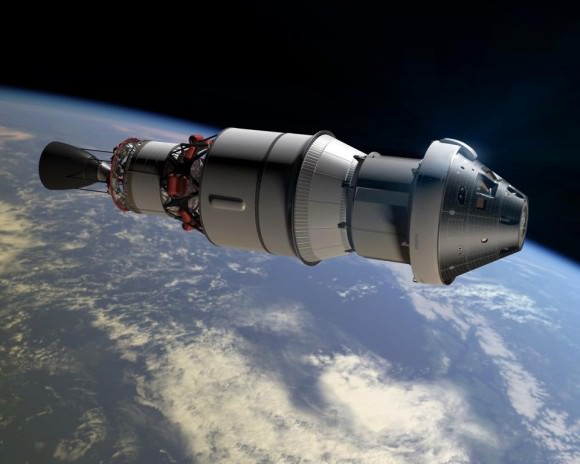
Watch Progress 42’s Fiery Re-Entry
The International Space Station crew were able to watch the Progress 42 cargo ship burn up in Earth’s atmosphere after it undocked from the ISS on October 29, 2011. We posted a single picture taken by Commander Mike Fossum earlier this week, but here’s a video compiled from several images from ISS cameras.
The video is from NASA’s Earth Observatory Astronaut Videos
Russia Considers Simulated Mars Mission on the Space Station
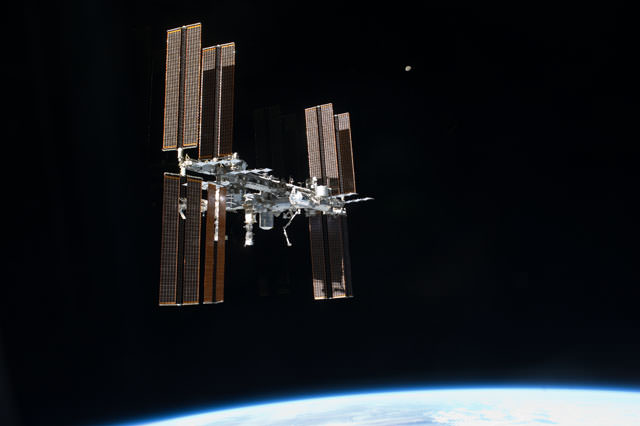
[/caption]
Russia and ESA are just finishing up a 500-day simulated Mars mission here on Earth, and now Roscosmos, Russia’s Federal Space Agency is considering taking it to the next level and conducting a “virtual” Mars mission experiment in space, on board the International Space Station. This tentative plan would have two cosmonauts and/or astronauts staying on board the ISS for up to 18 months, matching the potential length of a manned Mars mission.
“We are interested in staging such an experiment in actual conditions of zero gravity,” Roscosmos’ deputy head Vitaly Davydov told Itar-Tass. While there are so specific plans at this time, Davydov added that such a project might be possible after 2014, since the schedule of ISS work and its crews for the next two years have already been plotted.
As of now, crews on the space station usually stay no longer than 6 months, to avoid long-term bone and muscle mass loss, as well as keeping the crews “fresh.” Davydov said Russia cannot make such a decision unilaterally, and would have to get consent from other international partners in the program.
The major issues in doing this would be how the costs would be divided by the 16 countries involved the ISS program and which countries the astronauts would be from. If such a mission would be approved, it will be interesting to see how much interest there is by astronaut and cosmonaut corps for staying in space for 18 months.
Source: Itar-Tass
A Night Flight Over the Mideast
The cities of the Middle East and southern Asia shine bright in the night beneath the International Space Station as it passed high overhead on October 21, 2011.
This video, an animation made from dozens of still images taken by the Expedition 29 crew, was assembled by the Image Science and Analysis Laboratory at Johnson Space Center in Houston. It was uploaded to the Gateway to Astronaut Photography of Earth site on October 27.
[/caption]
Some glare from the Moon (off screen to the upper left) can be seen in the Plexiglas of the ISS window. The strobe-like flashes are lightning in clouds. Airglow is also visible as a band of hazy green light surrounding the planet.
Another particularly noticeable feature visible in this video is the bright orange line of the border between India and Pakistan. Erected by the Indian government to prevent smuggling, nearly 1200 miles (1930 km) of floodlights and fences separate the two countries, creating a geopolitical feature easily visible from orbit.
The website’s description states:
The sequence of shots was taken October 21, 2011 from 19:53:26 to 20:25:24 GMT, on a pass beginning over Turkmenistan, east of the Caspian Sea to southeastern China, just northwest of Hong Kong. City lights show at the beginning of the video as the ISS travels southeastward towards the India-Pakistan borderline (click here for the Earth Observatory article to learn more about this area). Pakistan’s second largest city, Lahore, can be easily seen as the brightly lit area left of track. Immediately downtrack of Lahore is New Delhi, India’s capital city, with the Kathiawar Peninsula right of track dimly lit. Smaller cities in southern India can be seen as the pass continues southeastward through southern India, into the Bay of Bengal. Lightning storms are also present, represented by the flashing lights throughout the video. The pass ends over western Indonesia, looking left of track at the island of Sumatra.
I particularly like the way the stars shine so prominently beyond Earth’s limb, and how the moonlight illuminates the clouds… not to mention the bloom of dawn at the end. What an incredible sight this must be for the ISS crew members! I can’t imagine ever getting tired of seeing this outside the Station windows.
Watch more ISS videos here.
Video courtesy of the Image Science & Analysis Laboratory, NASA Johnson Space Center.
NASA Up Close Tour: VAB and Space Shuttle Endeavour On Display
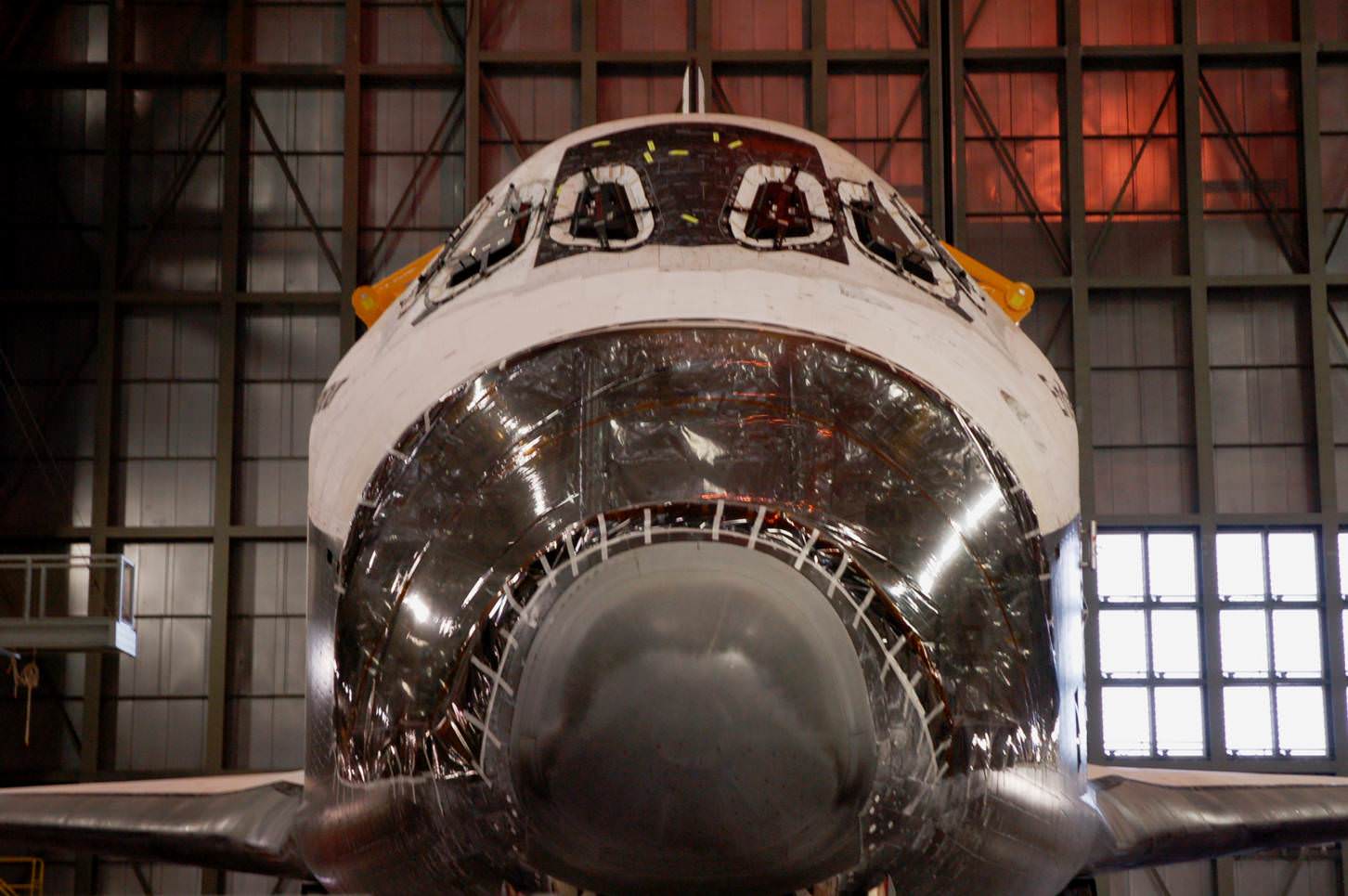
[/caption]
CAPE CANAVERAL, Fla – When guests visited the Kennedy Space Center Visitor Complex in the past, they never knew if they would have the opportunity to see an actual space shuttle in some stage of being processed for a mission. The operators of the Visitor Complex have changed that – guests will now not only get the chance to see space shuttle Endeavour (as well as potentially Atlantis and Discovery in the future) – but to also tour the cavernous Vehicle Assembly Building.
The opportunity to tour the VAB is currently being offered for a limited time and only to a limited number of Visitor Complex guests per day as part of KSC Up-Close, a new two-hour, guided special interest tour that began on Nov. 1. While touring inside the VAB itself is considered a treat, to actually be just a short distance away from one of the three remaining orbiters to conduct missions to and from orbit – is a rare thing indeed.
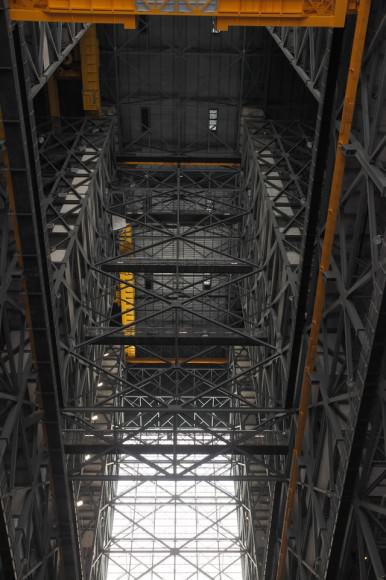
“We are very pleased to have the ability to offer to our guests the opportunity to see not just the inside of the Vehicle Assembly Building – but one of the orbiters as well,” said the Kennedy Space Center Visitor Complex’s Public Relations Manager Andrea Farmer. “While we don’t know the exact time frame – but this tour should be offered throughout 2012 and possibly into 2013.”
While undoubtedly one of the most memorable stops on the tour, the VAB tour stop is just one stop on this tour. Other stops include; NASA’s KSC Headquarters, the Operations & Checkout building (O&C), as well as the NASA Causeway providing a view of the adjacent Cape Canaveral Air Force Station.
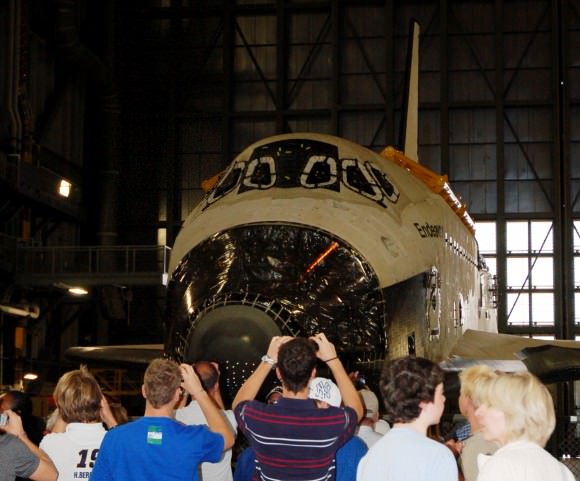
From here, guests can see launch pads 17, 37, 40, and 41, which are currently used for commercial and government launches.
After their stop at the VAB, guests will get to see the massive Crawler Transporters and “Crawlerway”. Guests will also get to see the Pegasus barge used to haul the shuttle’s large External Fuel Tanks (ETs) from Louisiana; the famous blue countdown clock and the Shuttle Landing Facility.
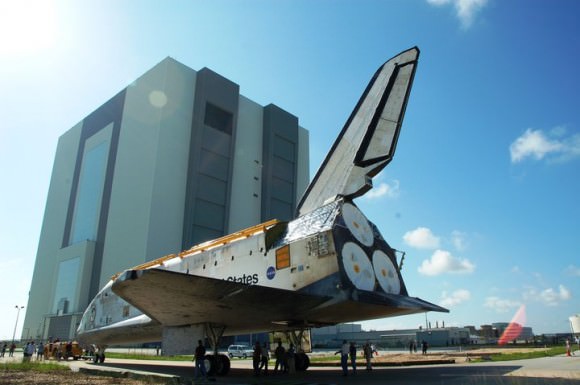
The last place that guests will visit is two hills where NASA remotely shoots launch photography and videography. On one side guests can see Launch Complexes 39A and B and on the other side is the Atlantic. This will provide guests to see the renovations that are currently being done to LC-39B in preparation for commercial launches or for the use for the Space Launch System (SLS).
Guests who had the opportunity to take the tour were amazed at what they were seeing, the sheer scale of the facilities and vehicles – as well as the history that they were walking through.
Three-time shuttle veteran Sam Gemar thinks that this new tour is important in allowing the public to gain a greater appreciation for U.S. human space flight efforts.
“Having flown to space myself, I cannot express strongly enough how much of a tremendous opportunity it is for the public to see the actual vehicles that have sent astronauts into space for the past three decades,” Gemar said. “Kennedy Space Center is where America goes to space and the KSC Up – Close tour allows us to share the history of the Vehicle Assembly Building with the world.”
Although the Visitor Complex cannot guarantee that whenever a guest arrives that they will be able to see a space shuttle inside the VAB (each of the orbiters are being processed for display in their new homes in Los Angeles, CA, Washington, D.C. and Florida. Eventually shuttle Atlantis, which will placed be display in a new facility at the Visitor Complex in 2013.
China Technology Surges Forward with Spectacular First Docking in Space
Video Caption: Live Video of Shenzhou-8 and Tiangong-1 docking in Earth orbit. Photos below. Credit: CCTV commentary/CMSE
China’s technological capabilities took a major surge forward with the successful docking in space today for the first time ever of two Chinese built and launched spaceships – orbiting some 343 kilometers in the heavens above at 1:37 a.m. Beijing time Nov. 3(1:37 p.m. EDT, Nov. 2). China’s goal is to build a fully operational space station in Earth orbit by 2020 – about the time when the ISS may be retired.
Today’s space spectacular joining together the Shenzhou-8 unmanned spacecraft and the Tiangong-1 prototype space station was an historic feat for China, which now becomes only the 3rd country to accomplish a rendezvous and docking of spacecraft in Earth orbit.
Shenzhou is China’s manned spaceflight capsule but is flying without a crew for this particular test flight. The prowess demonstrated with this triumph paves the way for further manned Shenzhou’s launches soon.
[/caption]
The remarkable space milestone follows in the footsteps of what the United States and Russia accomplished decades ago but this was carried out with 21st century science, technology and manufacturing abilities developed by China during the nation’s rapid rise over the past few decades to become the world’s 2nd most powerful economy.
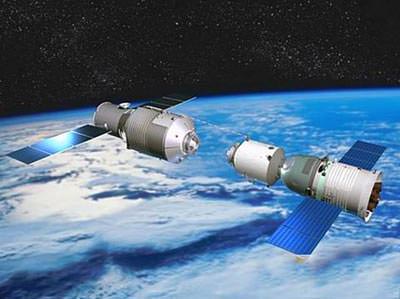
Shenzhou 8 has been chasing Tiangong-1 in orbit for two days since it was launched on Nov. 1 atop a Long March 2F booster rocket from the Gobi desert in northwest China.
The Commander-in-chief of China´s manned space program Gen. Chang Wanquan, announced “China’s first rendezvous and docking in space joining together the spacecraft Shenzhou-8 and Tiangong-1 space lab module was a complete success.” Chang leads the China Manned Space Engineering (CMSE) Project and pronounced the achievement at the Beijing Aerospace Control Center.
Chinese President Hu Jintao sent a congratulatory message from the G-20 summit in Cannes, France. “I am very pleased to hear the news and I send congratulations to all who made this possible. This will push China’s manned space program forward.”
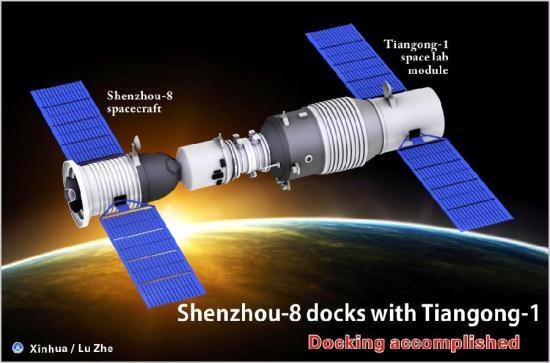
The landmark rendezvous and docking was carried live by state run CCTV for all the world to watch. The impressive 2 hour long TV broadcast showed simultaneous and breathtaking camera videos from both the unpiloted Shenzhou-8 capsule and the Tiangong-1 space station module as they viewed one another in the cameras field of view and slowly approached together with the lovely Earth as a backdrop.
Mission controllers carefully monitored all spacecraft systems on both Shenzhou-8 and Tiangong-1 as they sped closer at about 20 cm/sec and stopped at several parking points along the way (400 m, 140 m, 30 m) to confirm everything was nominal.
Chinese engineers and on board systems precisely guided the two spaceships and watched for any deviations. In case of any failures they had the capability to radio the vehicles to separate. But no deviations occurred and the autonomous docking proceeded to completion.
The two vehicles will remain docked for 12 days, then unhook and back off about 150 meters and then conduct another practice docking. The second practice docking is being done to gain more expertise and confidence and will be carried out under different conditions and in daylight.
The combined Shenzhou-8/Tiangong-1 orbiting complex weighs about 16 tons, some 8 tons each. Tiangong-1 is 10.4 m in length and 3.3. m in diameter. Shenzhou 8 is 9.2 m in length.
China plans two crewed flights to Tiangong-1 starting in 2012. The multi-person crews aboard Shenzhou 9 & Shenzhou 10 are almost certain to include China’s first female astronaut. The astronauts would float into Tiangong 1 from their Shenzhou capsules and remain on board for a few days or weeks. They will check out the spacecraft systems and conduct medical, space science and technology tests and experiments.
Meanwhile, since the premature retirement of the space shuttle with no successor in place, the US has absolutely no capability to launch astronauts to earth orbit. Therefore the ISS is totally reliant on Russian Soyuz rockets and capsules. US astronauts must hitch a ride to space with the Russians.
The US Senate just passed a NASA budget for 2012 that cuts NASA funding and will delay a replacement manned vehicle even further, likely into 2017. The US House seeks even deeper NASA budget cuts.
Thus China surges powerfully forward in space and science while the US political establishment has directed NASA to delay and retrench and layoff still more workers.
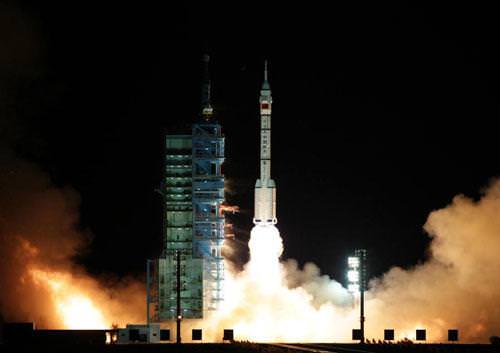
Read Ken’s related features about China’s Shenzhou-8, Tiangong-1 and Yinghou-1
China launches Shenzhou-8 bound for Historic 1st Docking in Space
Shenzhou-8 rolled out for Blastoff to China’s 1st Space Station on November 1
Bizarre Video: China’s Tiangong 1 Space Lab Animation set to ‘America the Beautiful’ Soundtrack
China Blasts First Space Lab Tiangong 1 to Orbit
China set to ‘Leap Forward in Space’ as Tiangong 1 Rolls to Launch Pad
Phobos-Grunt and Yinghou-1 Arrive at Baikonur Launch Site to tight Mars Deadline
Progress Cargo Ship Docks Successfully at ISS
Three days after launching on its Soyuz booster rocket, the Russian ISS Progress 45 cargo ship docked to the International Space Station on Nov. 2, 2011, delivering almost three tons of food, fuel and supplies. This is great news for the Space Station program, as the successful launch and today’s efficacious docking certainly bodes well for the resumption of crewed flights to the ISS, diminishing the prospect for having the ISS unmanned. Soyuz rocket launches were halted for almost 2 months after the unexpected failure and loss of the Progress 44 vehicle in August. Today, the unmanned Progress automatically linked up to the Pirs Docking Compartment on the Russian segment and the crew will soon begin unloading the supplies.
Today is also historic for the ISS program, as 11 years ago today the first expedition crew launched to the ISS.
Continue reading “Progress Cargo Ship Docks Successfully at ISS”
Progress Vehicle, Shooting Star, Or…?
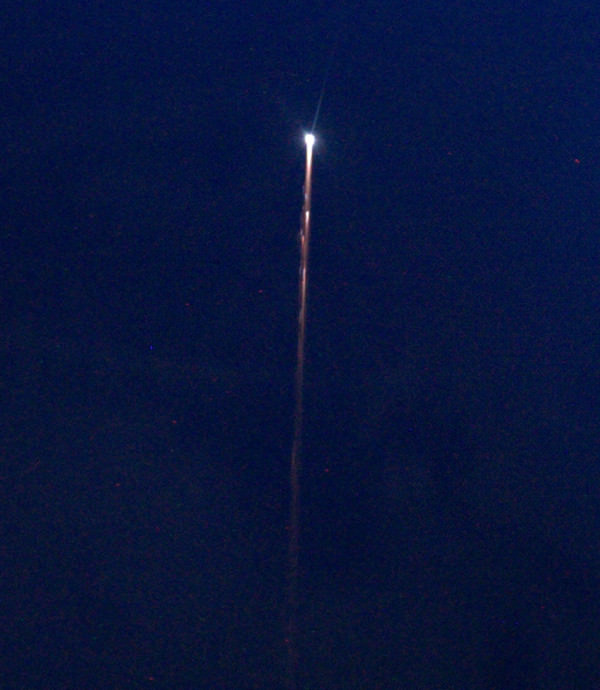
[/caption]
International Space Station Commander Mike Fossum captured this amazing view of the Progress M-10M cargo ship burning up in Earth’s atmosphere after it undocked from the space station on Saturday, Oct. 29, 2011. Via Twitter, astronaut Chris Hadfield — who is scheduled to command the ISS next year — said he received an email from Fossum about the picture, reminding him of a previous description Hadfield had given of what exactly is inside these departing cargo ships. It’s a video we’ve shared before, but it’s worth watching again.
Of course, the big news here is that the Progress M-10M was able to undock because of the successful launch of the Progress 45 vehicle last Friday, setting the stage for allowing the Soyuz crew ships to start flying again, lessening the probability that the ISS will have to go unmanned. Stay tuned for updates on the launch of the station’s next three residents, which is scheduled for Nov. 13, 2011.


